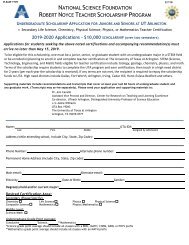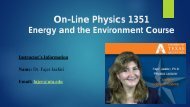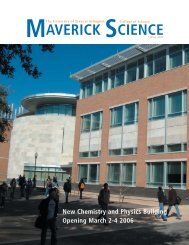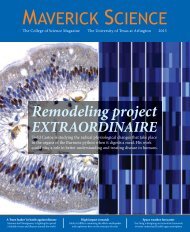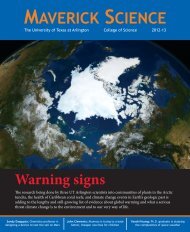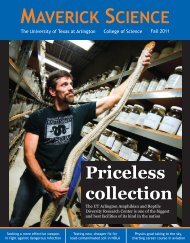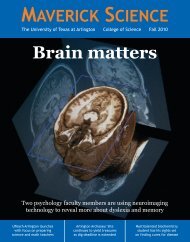Maverick Science mag 2013-14
Create successful ePaper yourself
Turn your PDF publications into a flip-book with our unique Google optimized e-Paper software.
school. While preparing for admission<br />
exams, Passy changed her mind and applied<br />
to the biology and chemistry departments at<br />
Sofia University. This pleased her father,<br />
who was a renowned professor of philosophy<br />
at the university, but chagrined her<br />
mother, an endocrinologist who wanted her<br />
to go into medicine.<br />
“In retrospect, this was the right decision<br />
— I do not handle suffering well, and open<br />
wounds are definitely out of the question,”<br />
Passy said. “I got accepted in both schools<br />
but biology was closer to my heart and I<br />
chose it over chemistry. This was fortunate<br />
because later on, I realized that mixing acrid<br />
and caustic substances in the lab and ruining<br />
my clothes wasn’t my thing either.”<br />
She earned an undergraduate degree in<br />
1984, focusing on molecular biology. She<br />
stayed at Sofia University and began work<br />
on a master’s degree, switching to paleoecology<br />
and studying diatom remains from an<br />
ancient sea that covered parts of Europe and<br />
Central Asia. After earning a master’s degree<br />
in 1986, she worked as an assistant professor<br />
of plant systematics at Sofia University before<br />
deciding to begin doctoral studies. She<br />
felt the best course was to conduct those<br />
studies in the United States.<br />
“I had the feeling that I had reached the<br />
limits of my environment,” Passy said of the<br />
educational opportunities in her native Bulgaria.<br />
“People refer to the United States as<br />
the land of opportunity, and although they<br />
generally mean material prosperity, this<br />
view cannot be truer anywhere else than in<br />
science. We have witnessed an unprecedented<br />
surge of wealth in the post-communist<br />
world, but the advancement of science<br />
has not kept pace.<br />
“I came to the U.S. to learn, and what I<br />
have learned made so much that was out of<br />
reach for me before a reality.”<br />
She was accepted to the Ph.D. program at Bowling Green State University<br />
in Ohio in 1992 and wrote her dissertation on water quality issues<br />
— how algal communities respond to organic pollution in streams.<br />
“While working on my dissertation, I stumbled upon six algal species<br />
from Bulgaria and South Africa, which I described as new to science,” she<br />
said. “South Africa is known for its enormous plant biodiversity — comparable,<br />
for example, to that of the tropical rainforest. So it was fascinating<br />
to me that in a small scoop of the stream biofilm — the stuff that grows on<br />
the bottom — from this region, there were so many algae never seen before.”<br />
After earning her Ph.D. in 1997, she spent four years as a postdoctoral<br />
researcher — first in protein structural biology at the University of Minnesota<br />
and then in bio-monitoring at the Rensselaer Polytechnic Institute,<br />
a private research university in Troy, N.Y. where she began her collaboration<br />
with the USGS on acidification research. In 2000, she saw a posting<br />
for a biology faculty position at UT Arlington. She had visited Texas once<br />
before, and the thought of living in a warm climate enticed her.<br />
“Having spent all my life in the northern latitudes, I was enchanted by<br />
Texas when I visited for the first time in the spring of 1997,” she said. “It<br />
was sunny, warm, and beautiful. There were flowers everywhere, and the<br />
air was filled with hope and happiness. I was even more excited when I<br />
came to visit in 2000 during my UTA interview. I already knew many of<br />
the faculty from their works, but it was the possibility to interact with such<br />
a diverse and fun group of scientists that sold the job for me.”<br />
“is research<br />
has far-reaching<br />
consequences<br />
for biodiversity<br />
conservation<br />
and stream<br />
management.”<br />
— Sophia Passy<br />
Jonathan Campbell, professor and chair<br />
of the UT Arlington biology department, was<br />
impressed by Passy when he interviewed her<br />
for the job and is even more impressed 13<br />
years later.<br />
“Dr. Passy's dedication and passion for<br />
research is exceptional and her enthusiasm<br />
is revealed in any conversation with her<br />
about her work,” Campbell said. “She is able<br />
to inspire her students with the excitement<br />
and importance of conducting research. Her<br />
work on stream acidification is making a significant<br />
impact in her field. We are lucky to<br />
have her in our department.”<br />
T<br />
he use of macroecology in<br />
Passy’s research is maybe<br />
best demonstrated in a<br />
study that she says is “perhaps<br />
my best piece of detective<br />
work.” For decades,<br />
stream ecologists thought<br />
that major nutrients such as nitrogen and<br />
phosphorus control algal communities,<br />
which are the primary food source for herbivorous<br />
bugs and fish in many streams,<br />
Passy explained.<br />
The paradigm was that these nutrients<br />
stimulate growth and promote biodiversity<br />
of algae in freshwater. A similar emphasis on<br />
macronutrients (nutrients required in large<br />
quantities) was given in marine systems. In<br />
the late 1980s, however, the idea that iron restricted<br />
algal production in large areas of the<br />
open ocean revolutionized the field of<br />
oceanography.<br />
“This is where macroecology comes into<br />
play. I was working on a very puzzling problem<br />
— the biodiversity of algae did not show<br />
a decline with latitude as in nearly all other<br />
organisms, but a very strange pattern,” she<br />
said. “To understand what might have<br />
caused it, I looked what stream and watershed<br />
properties across the U.S. exhibit corresponding latitudinal distributions.<br />
I discovered that both stream iron concentration and wetland spread<br />
conformed to the same latitudinal pattern as algal biodiversity.<br />
“Contrary to the common belief, it was not nitrogen and phosphorus<br />
that had the strongest positive impact on stream algae. It was iron, which<br />
originated from the watershed wetlands. Simply put, the larger the wetland<br />
the higher the iron concentration, and the greater the algal biodiversity in<br />
the stream. Therefore, wetland destruction or alteration will have negative<br />
consequences not only for the wetland itself but for the associated stream<br />
network.”<br />
Passy’s macroecology approach challenged the macronutrient paradigm<br />
in streams. It also revealed that — similarly to the ocean — iron plays<br />
a pivotal role in structuring algal communities, and it showed that wetlands<br />
and streams form an ecological continuum, whereby a disruption in one<br />
system would propagate to the other. The work was published in the leading<br />
ecology journals Global Ecology and Biogeography in 2009 and Ecology<br />
in 2010.<br />
The work demonstrated Passy’s ability to see patterns and understand<br />
how processes viewed in the micro environment can significantly affect<br />
things on a much larger scale.<br />
“Any small scale experiment or observation captures just a facet of the<br />
complexity of life,” Passy said. “Macroecology puts these facets together,<br />
allowing us to understand better how nature works. That’s why I love what<br />
I’m doing so much.” n<br />
<strong>Maverick</strong> <strong>Science</strong> <strong>2013</strong>-<strong>14</strong><br />
31



